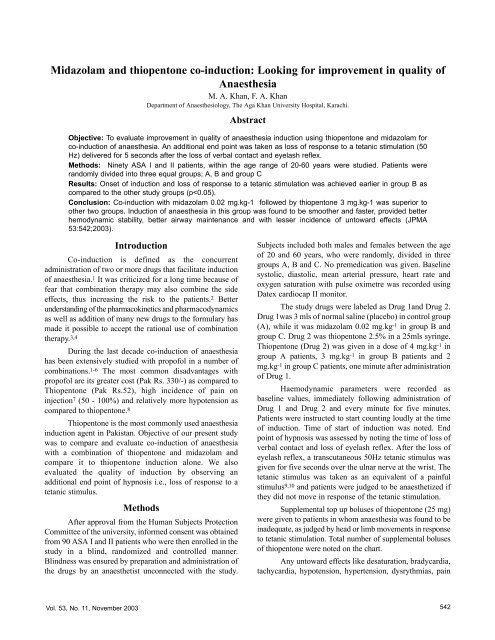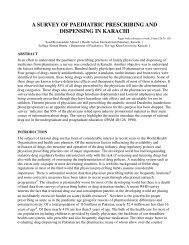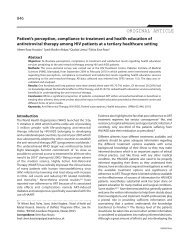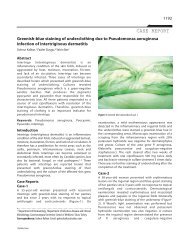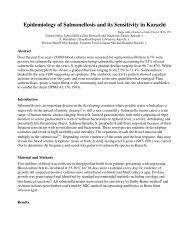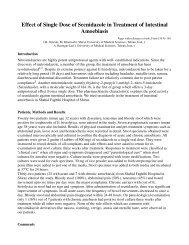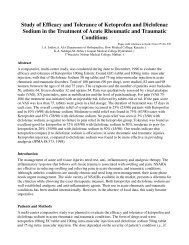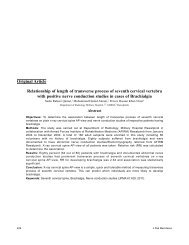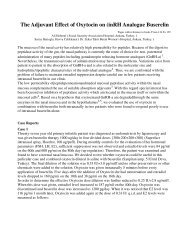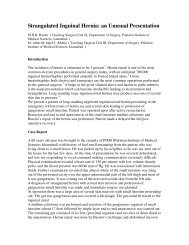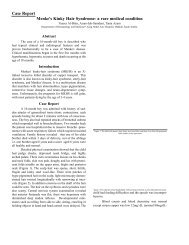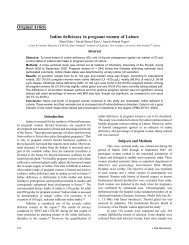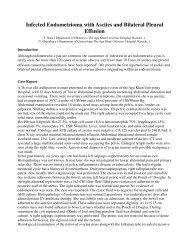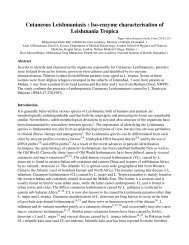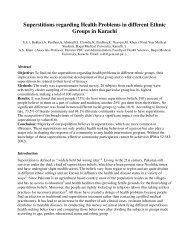Midazolam and thiopentone co-induction - ResearchGate
Midazolam and thiopentone co-induction - ResearchGate
Midazolam and thiopentone co-induction - ResearchGate
Create successful ePaper yourself
Turn your PDF publications into a flip-book with our unique Google optimized e-Paper software.
<strong>Midazolam</strong> <strong>and</strong> <strong>thiopentone</strong> <strong>co</strong>-<strong>induction</strong>: Looking for improvement in quality of<br />
Anaesthesia<br />
M. A. Khan, F. A. Khan<br />
Department of Anaesthesiology, The Aga Khan University Hospital, Karachi.<br />
Introduction<br />
Co-<strong>induction</strong> is defined as the <strong>co</strong>ncurrent<br />
administration of two or more drugs that facilitate <strong>induction</strong><br />
of anaesthesia. 1 It was criticized for a long time because of<br />
fear that <strong>co</strong>mbination therapy may also <strong>co</strong>mbine the side<br />
effects, thus increasing the risk to the patients. 2 Better<br />
underst<strong>and</strong>ing of the pharma<strong>co</strong>kinetics <strong>and</strong> pharma<strong>co</strong>dynamics<br />
as well as addition of many new drugs to the formulary has<br />
made it possible to accept the rational use of <strong>co</strong>mbination<br />
therapy. 3,4<br />
During the last decade <strong>co</strong>-<strong>induction</strong> of anaesthesia<br />
has been extensively studied with propofol in a number of<br />
<strong>co</strong>mbinations. 1-6 The most <strong>co</strong>mmon disadvantages with<br />
propofol are its greater <strong>co</strong>st (Pak Rs. 330/-) as <strong>co</strong>mpared to<br />
Thiopentone (Pak Rs.52), high incidence of pain on<br />
injection7 (50 - 100%) <strong>and</strong> relatively more hypotension as<br />
<strong>co</strong>mpared to <strong>thiopentone</strong>. 8<br />
Thiopentone is the most <strong>co</strong>mmonly used anaesthesia<br />
<strong>induction</strong> agent in Pakistan. Objective of our present study<br />
was to <strong>co</strong>mpare <strong>and</strong> evaluate <strong>co</strong>-<strong>induction</strong> of anaesthesia<br />
with a <strong>co</strong>mbination of <strong>thiopentone</strong> <strong>and</strong> midazolam <strong>and</strong><br />
<strong>co</strong>mpare it to <strong>thiopentone</strong> <strong>induction</strong> alone. We also<br />
evaluated the quality of <strong>induction</strong> by observing an<br />
additional end point of hypnosis i.e., loss of response to a<br />
tetanic stimulus.<br />
Methods<br />
After approval from the Human Subjects Protection<br />
Committee of the university, informed <strong>co</strong>nsent was obtained<br />
from 90 ASA I <strong>and</strong> II patients who were then enrolled in the<br />
study in a blind, r<strong>and</strong>omized <strong>and</strong> <strong>co</strong>ntrolled manner.<br />
Blindness was ensured by preparation <strong>and</strong> administration of<br />
the drugs by an anaesthetist un<strong>co</strong>nnected with the study.<br />
Vol. 53, No. 11, November 2003<br />
Abstract<br />
Objective: To evaluate improvement in quality of anaesthesia <strong>induction</strong> using <strong>thiopentone</strong> <strong>and</strong> midazolam for<br />
<strong>co</strong>-<strong>induction</strong> of anaesthesia. An additional end point was taken as loss of response to a tetanic stimulation (50<br />
Hz) delivered for 5 se<strong>co</strong>nds after the loss of verbal <strong>co</strong>ntact <strong>and</strong> eyelash reflex.<br />
Methods: Ninety ASA I <strong>and</strong> II patients, within the age range of 20-60 years were studied. Patients were<br />
r<strong>and</strong>omly divided into three equal groups; A, B <strong>and</strong> group C<br />
Results: Onset of <strong>induction</strong> <strong>and</strong> loss of response to a tetanic stimulation was achieved earlier in group B as<br />
<strong>co</strong>mpared to the other study groups (p
on injection, hiccups <strong>and</strong> hypersensitivity reactions were<br />
also noted. Desaturation was defined as mild when oxygen<br />
saturation fell below 95% but remained above 90%,<br />
moderate between 86 % <strong>and</strong> 89 % <strong>and</strong> severe if it fell below<br />
86%. Bradycardia was defined as the heart rate below 60<br />
beats.min -1, <strong>and</strong> tachycardia as heart rate above 100 beats<br />
min -1. Hypertension was defined as blood pressure values<br />
(systolic, diastolic <strong>and</strong> mean), 20% above baseline <strong>and</strong><br />
hypotension as 20% below the baseline values.<br />
Statistical Analysis<br />
Power analysis was used to determine the number of<br />
patients based on the assumption that for an α-value of 0.05<br />
<strong>and</strong> a power (1-ß) of 0.8, 30 patients were required in each<br />
group. Variables were entered <strong>and</strong> analyzed on statistical<br />
package epi-info 6. The mean change in systolic, diastolic,<br />
mean arterial pressure, heart rate, <strong>and</strong> time to achieve<br />
anaesthesia were <strong>co</strong>mpared between the three groups using<br />
ANOVA. Categorical variables were <strong>co</strong>mpared using chisquare<br />
test; p-value of less than 0.05 was <strong>co</strong>nsidered<br />
significant.<br />
Results<br />
Demographic data<br />
Table 1 shows the demographic data. No significant<br />
difference was observed in age, weight <strong>and</strong> height between<br />
groups.<br />
Hypnosis<br />
The end point of hypnosis was assessed by loss of<br />
verbal <strong>co</strong>ntact, loss of eyelash reflex <strong>and</strong> loss of response to<br />
tetanic stimulation (50 Hz), as shown in table 2.<br />
Loss of verbal <strong>co</strong>ntact, occurred earlier in group B<br />
(28.6 ± 6) se<strong>co</strong>nds. The values for group A were 29.1 ± 5<br />
se<strong>co</strong>nds <strong>and</strong> for group C were 30.2 ± 6 se<strong>co</strong>nds.<br />
Loss of eyelash reflex was earliest in group B, 36.2<br />
± 8 se<strong>co</strong>nds. The values were 39.4 ± 7 <strong>and</strong> 40.3 ± 8 se<strong>co</strong>nds<br />
in group A <strong>and</strong> group C respectively.<br />
Loss of response to tetanic stimulation. Patients in<br />
group B achieved anaesthesia in shortest time when this<br />
criteria was used as the end point of anaesthesia (40.6 ±8<br />
543<br />
Table 1. Demographic data.<br />
No. Age (years) Weight (kgs) Height<br />
(cms)<br />
Group A 30 38.9+11 62.9+8.9 162.7+5.3<br />
Group B 30 35.0+8.3 65.4+9.6 160.8+7.6<br />
Group C 30 37.6+9.3 64.0+9.7 161.9+10.3<br />
Table 2. Evaluation of hypnosis.<br />
A<br />
Groups<br />
B C<br />
Loss of verbal <strong>co</strong>ntact (se<strong>co</strong>nds) 29.1+5 28.6+6* 30.2+6<br />
Loss of eyelash reflex (se<strong>co</strong>nds)<br />
Loss of response to titanic<br />
39.4+7 36.2+8* 40.3+8<br />
Stimulation 50 Hz (se<strong>co</strong>nds) 45.8+7 40.6+8*~ 50.4+2<br />
* =p
Figure 1. Systolic blood pressure variation from baseline values (Mean+SD).<br />
Table 4. Change in oxygen saturation during <strong>induction</strong>.<br />
Decline in oxygen<br />
saturation (%)<br />
A<br />
Groups<br />
B C<br />
Mild 90-95 14 13 16<br />
Moderate 86-89 2 2 5<br />
Severe
different between the three groups.<br />
Bradycardia: Non of the patients in group B developed<br />
bradycardia as <strong>co</strong>mpared to four patients in group A <strong>and</strong> one<br />
in group B. The difference among the groups was not<br />
statistically significant.<br />
Tachycardia: Five patients in group A, eight in group B<br />
<strong>and</strong> eight in group C developed tachycardia. This difference<br />
was not statistically significant.<br />
Hypotension: Four patients in group A, three in group B<br />
<strong>and</strong> three in group C developed hypotension.<br />
Hypertension: Two patients in group A, four in group B<br />
<strong>and</strong> seven in group C developed hypertension. The<br />
difference was not statistically significant.<br />
Pain on injection: Three patients in group A, one in group<br />
B <strong>and</strong> non in group C <strong>co</strong>mplained of pain on injection.<br />
Arrythmias: No patient developed arrhythmia in either<br />
group.<br />
Hiccups: Only one patient in group B developed hiccups.<br />
Hypersensitivity reactions: No patient in any group<br />
developed a hypersensitivity reaction.<br />
Discussion<br />
Thiopentone is the most <strong>co</strong>mmonly used anaesthesia<br />
<strong>induction</strong> agent in Pakistan. It has been the 'gold st<strong>and</strong>ard'<br />
for <strong>induction</strong> of anaesthesia. Side effects are apnea,<br />
hypotension <strong>and</strong> adverse sequelae associated with<br />
accidental extra vascular injection. 11,12<br />
One of the fundamental features of good quality<br />
anaesthesia is amnesia i.e., patient should be <strong>co</strong>mpletely<br />
unaware of the events during surgery. The incidence of<br />
awareness in non-obstetrical <strong>and</strong> non-cardiac surgical cases<br />
is reported to be 0.2%. A higher incidence has been reported<br />
in cardiac surgery (1.1-1.5%), obstetric surgery (0.4%) <strong>and</strong><br />
major trauma cases (11-41%). 13 Perioperative awareness<br />
may cause anxiety, pain, panic <strong>and</strong> hemodynamic<br />
instability (e.g. rise in heart rate <strong>and</strong> blood pressure), while<br />
its postoperative sequelae may lead to post traumatic stress<br />
disorder including repetitive night mares, anxiety <strong>and</strong><br />
irritability, a preoccupation with death <strong>and</strong> <strong>co</strong>ncern with<br />
sanity.<br />
Light anaesthesia is claimed to be the major factor<br />
responsible for awareness. In cardiac surgery <strong>and</strong> major<br />
trauma cases hemodynamic instability is the major <strong>co</strong>ncern<br />
at <strong>induction</strong> of anaesthesia. Fall in blood pressure associated<br />
with administration of <strong>thiopentone</strong> can aggravate this<br />
untoward effect. The dose of <strong>thiopentone</strong> is therefore<br />
reduced to avoid hypotension. Reduction of the dose of<br />
<strong>thiopentone</strong> may lead to awareness. Loss of verbal <strong>co</strong>ntact<br />
<strong>and</strong> loss of eyelash reflex has been taken as the endpoint of<br />
545<br />
hypnosis by most of anaesthetists <strong>and</strong> the dose of<br />
<strong>thiopentone</strong> is titrated to achieve this end point. However<br />
observation of voluntary movements or movement response<br />
to noxious stimuli is the best clinical measure available for<br />
detecting wakefulness or impending wakefulness. 13<br />
Premedication with amnesic drugs e.g., midazolam is<br />
re<strong>co</strong>mmended as one of the techniques to prevent<br />
awareness.<br />
<strong>Midazolam</strong>, a water-soluble benzodiazepine is used<br />
as an intravenous <strong>induction</strong> agent in a dose of 0.125 to 0.2<br />
mg.kg-1. Side effects include apnea, mild burning sensation<br />
at the injection site <strong>and</strong> slight decrease in systolic blood<br />
pressure. Advantages include short duration of action <strong>and</strong><br />
cardiovascular stability. 14,15 The sedative <strong>and</strong> hypnotic<br />
effects of barbiturates <strong>and</strong> benzodiazepines are mediated<br />
through separate receptors within the Gama amino-butyric<br />
acid (GABA) supra-molecular <strong>co</strong>mplex. 1 When used in<br />
<strong>co</strong>mbination, a synergistic interaction has been found<br />
between the two. 3,4,6,15 Barbiturates allosterically enhance<br />
benzodiazepine binding to the benzodiazepine receptors. 6<br />
This interaction is mutual i.e., <strong>thiopentone</strong> potentiates the<br />
effect of midazolam <strong>and</strong> midazolam potentiates<br />
<strong>thiopentone</strong>.<br />
Several authors have studied <strong>co</strong>-<strong>induction</strong> of<br />
anaesthesia with <strong>thiopentone</strong> <strong>and</strong> midazolam. 6,12,16 Some of<br />
the previous studies have shown that a low sub-hypnotic<br />
dose of midazolam (0.02 mg.kg-1) reduces the <strong>induction</strong><br />
dose of <strong>thiopentone</strong> by 50%. 1,4,6 These studies took the<br />
onset of hypnosis as the only end point of <strong>induction</strong>. In our<br />
present study, we evaluated <strong>co</strong>-<strong>induction</strong> with <strong>thiopentone</strong><br />
<strong>and</strong> midazolam <strong>co</strong>mbination <strong>and</strong> studied three different end<br />
points. In addition to loss of verbal response <strong>and</strong> loss of<br />
eyelash reflex, a tetanic stimulus of 50 Hz was also applied<br />
for 5 se<strong>co</strong>nds over the ulnar nerve in forearm.Tetanic<br />
stimulation is <strong>co</strong>nsidered equivalent to a painful stimulus9,11 <strong>and</strong> has not been <strong>co</strong>nsidered an end point of <strong>induction</strong> in<br />
other studies.<br />
Our results showed that, patients in group B i.e.<br />
midazolam 0.02 mg.kg-1 followed by <strong>thiopentone</strong> 3 mg.<br />
kg-1 were found to achieve hypnosis in significantly shorter<br />
time (p
interpreted as ' when hypnosis is taken as the end point of<br />
anaesthesia, midazolam 0.02 mg.kg-1 reduced the <strong>induction</strong><br />
dose of <strong>thiopentone</strong> by 50%, but when tetanic stimulation<br />
was taken as the end point of anaesthetic <strong>induction</strong>, a 50%<br />
reduced dose of <strong>thiopentone</strong> was not sufficient to produce<br />
adequate anaesthesia. Co-<strong>induction</strong> with midazolam 0.02<br />
mg.kg-1 <strong>and</strong> <strong>thiopentone</strong> in a dose of 3 mg.kg-1 on the other<br />
h<strong>and</strong> produced adequate anaesthesia when tetanic<br />
stimulation was taken as the end point. Co-<strong>induction</strong> with<br />
midazolam 0.02 mg.kg-1 also reduced the <strong>induction</strong> dose of<br />
<strong>thiopentone</strong> by 25%. This has been reported as 50% by<br />
other authors. 1,3,4<br />
Haemodynamic variation from baseline values was<br />
less in group B as <strong>co</strong>mpared to other groups but this<br />
difference was not statistically significant. There was a<br />
statistically significant difference (p
4. Vinik HR. Anaesthetic interactions. Eur J Anaesthes 1995;12(Suppl.<br />
12): 3-4.<br />
5. Vinik HR, Bradely EL Jr, Kissen I. Triple anesthetic <strong>co</strong>mbination: propofolmidazolam-alfentanil.<br />
Anesth Analg 1994;78:354-8.<br />
6. Vinik HR. A practical application of anaesthetic drug interaction. Curr Opin<br />
Anaesth 1993;6 (Suppl. 1):S9-13.<br />
7. Pollard RC, Makky S. A 3:1 volume admixture of 1% propofol <strong>and</strong> 2.5%<br />
<strong>thiopentone</strong> reduces pain on <strong>induction</strong> in paediatric anaesthesia. Paesiatr<br />
Anaesth 2002;12:833-4.<br />
8. Benson M, Unger A. Use of an anesthesia information management system<br />
(AIMS) to evaluate the physiologic effects of hypnotic agents used to induce<br />
anesthesia. J Clin Monit Comput 2000;16:183-90.<br />
9. Kazama T, Ikeda K, Morita K. Reduction by Fentanyl of the Cp 50 values of<br />
propofol <strong>and</strong> hemodynamic responses to various noxious stimuli.<br />
Anesthesiology 1997;87:213-27.<br />
10. Leslie K, Sessler DI, Smith WD, et al. Prediction of movement during<br />
propofol/nitrous oxide anaesthesia. Performance of <strong>co</strong>ncentration,<br />
electroencephalographic, pupillary, <strong>and</strong> hemodynamic indicators.<br />
Anesthesiology 1996;84:152-63.<br />
11. Vinik H. R. <strong>Midazolam</strong> for <strong>co</strong>-<strong>induction</strong> of thiopental anaesthesia in patients.<br />
Anaesthesiology 1990;73:3A.<br />
12. Trevskoy M, Fleyshaman G, Bradly EL Jr, et al. <strong>Midazolam</strong>-Thiopentone<br />
anesthetic interaction in patients. Anesth Analg 1988;67:342-5.<br />
13. Ghoneim MM. Awareness during anesthesia. Anesthesiology 2000;92:<br />
597-602.<br />
14. Reves JG, Fragen RJ, Vinik HR, et al. <strong>Midazolam</strong>: pharma<strong>co</strong>logy <strong>and</strong> uses.<br />
Anaesthesiology 1985;62:310-24.<br />
15. Kissin I, Brown PT, Bradely EL Jr, et al. Diazepam-morphine hypnotic<br />
synergism in rats. Anesthesiology 1989;70:689-94.<br />
16. Kissin I, Brown PT, Bradely EL. Is benzodiazepine barbiturate anesthetic<br />
synergism one sided? Anesth Analg 1990;70:S205.<br />
17. Thrope M, Gauntlett IS. Arterial oxygen saturation during <strong>induction</strong> of<br />
anaesthesia. Anaesthesia.1990;45:1012-15.<br />
18. Wood M. Intravenous anesthetic agents. In: Wood M, Alastair JJ. Drugs <strong>and</strong><br />
Anesthesia. Baltimore: Williams <strong>and</strong> Wilkins 1990;179-223.


